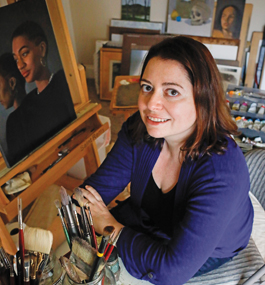Her Designs Are on the Money — Literally

Nancy Fields, Big Dreamz Creative
Elana Hagler ’02
Elana Hagler ’02 sold her first piece of art as a young girl. Commissioned for the cover of a friend’s notebook, the drawing depicted what Hagler recalls as a “particularly gnarly” skeleton with wings. The payment, she says, was “the impressive sum of one quarter.”
In an odd twist of fate, Hagler is once again producing art for a quarter. Working with the U.S. Mint, the bureau within the Department of Treasury responsible for producing the nation’s coin supply, she contributed a design to the newly launched American Women Quarters Program, which will, through 2025, produce five coins a year celebrating female historical figures.
Hagler designed the “tails” side of the commemorative quarter honoring Sally Ride, the first American woman in space. The other honorees in the inaugural commemorative set, released in March, are poet Maya Angelou, film star Anna May Wong, activist Wilma Mankiller and suffrage leader Nina Otero-Warren.
Creating the Ride portrait was a “deeply meaningful” experience, Hagler says, knowing that the astronaut “shattered a glass ceiling by busting through it on a rocket, and inspired countless others to climb to new heights.”
Her design portrays Ride, who was also a physicist, next to a space-shuttle window, with Earth in the background, a nod to Ride’s description of her time in space: “When I wasn’t working, I was usually at a window looking down at Earth.”
One of a number of design contenders, Hagler’s rendering of Ride was recommended by the U.S. Commission of Fine Arts and the Citizens Coinage Advisory Committee, and selected for minting by treasury secretary Janet Yellen.
The coin is the second design by Hagler that has been selected for minting; the first was a $1 coin that honored former President George H.W. Bush in 2020.
Hagler didn’t always plan on turning art into a profession. When she arrived at Brandeis, she majored in neuroscience and psychology. Halfway through her studies, she dropped neuroscience and picked up fine arts as a major. Today, she is an assistant professor of art at Alabama State University, where she teaches painting and drawing.
She says her Brandeis education has come in handy during her work with the U.S. Mint, especially when she’s tasked with researching people, inventions or moments in history. “When I was seeking out the best technical and philosophical training in art, I already had a very strong liberal arts education, which bolstered me in every way,” she explains. “I had learned how to learn, and that is priceless.”
Now the Ride coin may inspire a little girl to find out more about astrophysics or space travel. Or perhaps it will be used to purchase work from an artist just beginning to discover her calling.
— David Eisenberg
